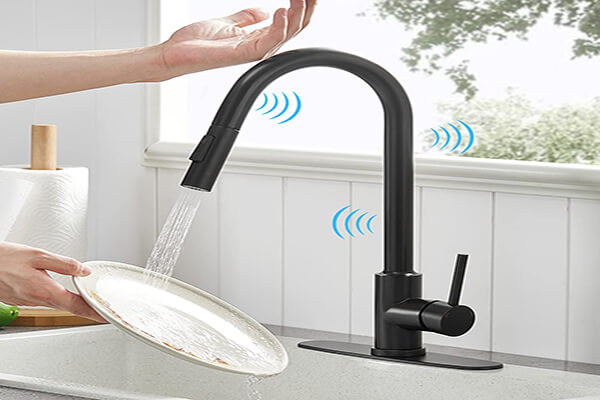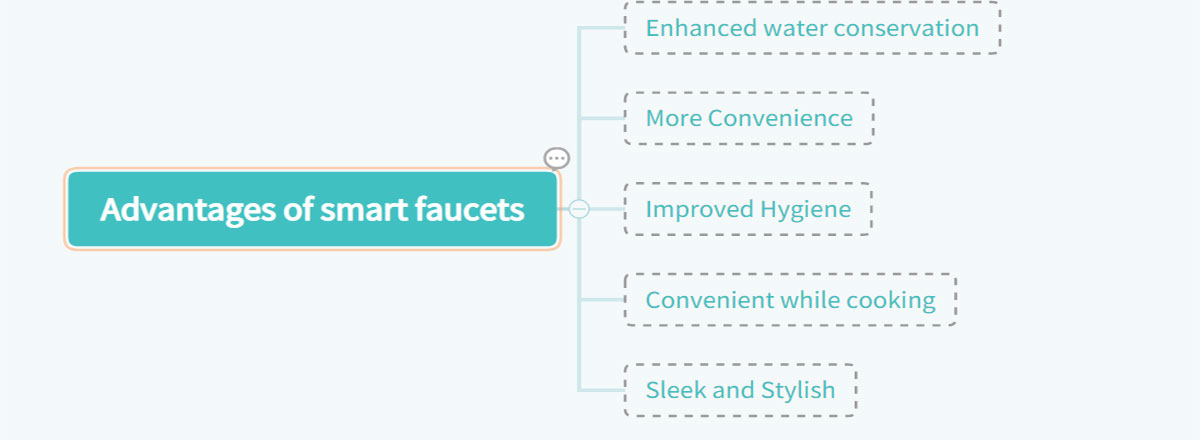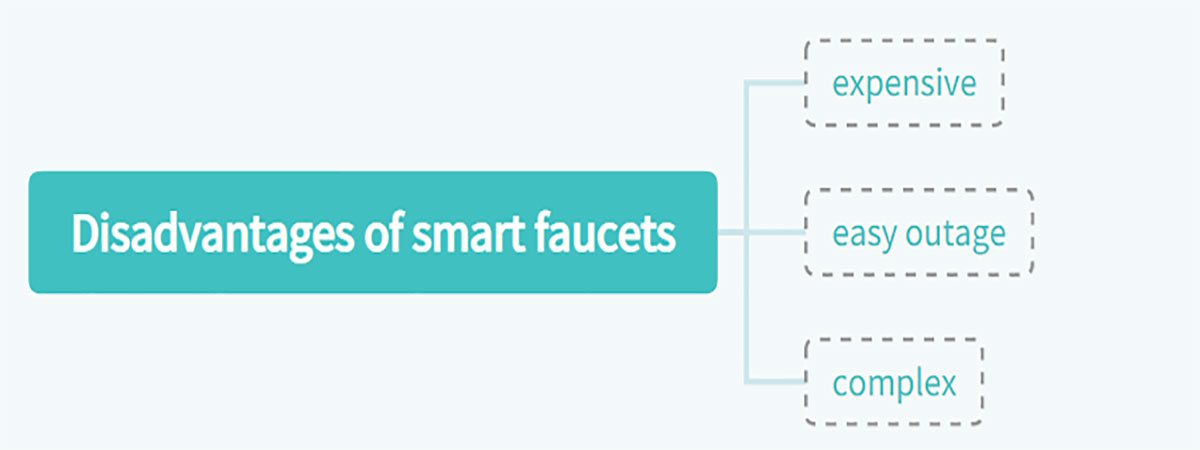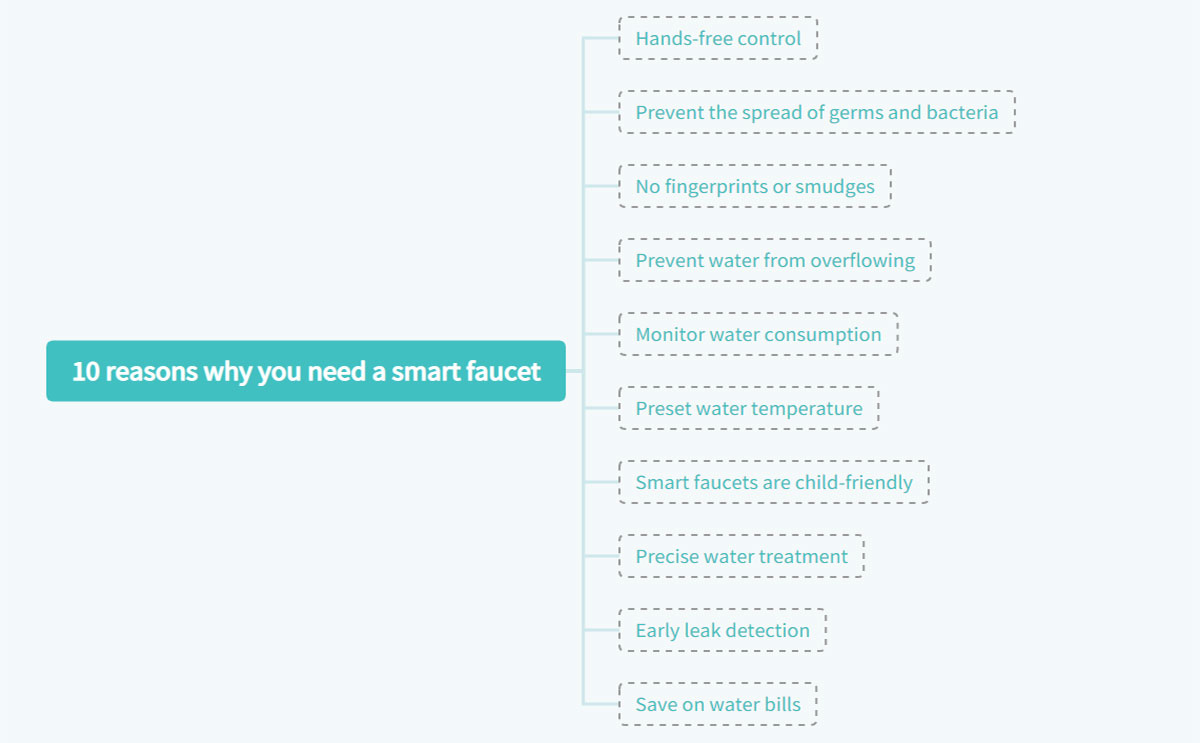Remember the first time you encountered a touchless faucet in a public bathroom? You can turn it on and off with a wave of your hand. Such smart sinks have been around in commercial restrooms and spaces for years, but now they’re becoming more common in home kitchens and bathrooms. In today’s guide, we’ll take a closer look at what smart faucets are, how they work, their types, and their pros and cons.
1. What is a smart faucet?
Smart faucets are automatic faucets with electronic sensors. These sensors turn the water flow on (and off) when they detect movement, so you don’t have to turn the faucet knob. Most include hands-free operation via touch or motion.
Plus, some are even voice-activated, allowing you to do things like fill containers and adjust water temperature without touching the faucet. Some smart faucets are battery-powered, while others connect to a power source beneath the sink. For an average home, the battery pack has a runtime of two to five years, with leading brands using AA or C batteries for longer life.
If the power goes out or the battery dies, the smart faucet will still work. Until power is restored, you lose smart functionality and can only use regular faucets.
Additionally, smart faucets have a solenoid valve, which is “a solenoid valve that turns the water on and off,” Wood explains. Solenoid valves can be found everywhere in your home—in smart locks, cars, washing machines, and even ice machines. A smart faucet’s solenoid valve can be activated with or without touch.
(Another related post: Kitchen Faucet Flow: Everything You Need to Know)
2. How do smart faucets work?
You may feel like the genie is running your smart faucet. But it’s not exactly magic, it’s actually something more mundane.
With a motion-sensing device, you’ll notice a box under the sink; it’s the mechanism that responds to your commands. It contains a solenoid valve that allows water to flow through the faucet. Once activated, the solenoid valve initiates the flow of water; then, after the shutdown timer is activated, restricts the flow of water through the tank – like a small dam.
Of course, your smart devices need power to meet your requirements. Some draw power from a power source they plug into (a box under the sink). Others use batteries (AA and C are the most popular). These batteries last between two and five years.
The smartest smart faucet is operated via an app. Smart sinks from some manufacturers, like Moen, are compatible with virtual assistants like Amazon Alexa. This is often how voice-controlled devices work.
3. What types of smart faucets are there?
The term smart faucet is actually a general term for various devices with certain operating technologies. Among the varieties:
- Touchless: These faucets use motion sensors to capture the hand swipe that activates them.
- One-Touch: Activate the faucet with just a tap of your hand, elbow, or, in some cases, foot (usually anywhere on the device).
- Voice function: Voice commands to turn on the water, adjust the temperature, and turn off power.
- All-in-one: Some models feature voice commands and a one-touch water app.
Additionally, many smart faucets offer digital displays that show you the exact water temperature so you can adjust it—similar to a water thermostat.
No matter how they turn the water on or off – motion, one-touch, or voice command – the point is, that smart faucets are powered, as opposed to manually operated regular faucets.
(Another related post: Kitchen Faucet: An Ultimate FAQ Guide)
4. Advantages of smart faucets
Smart faucets have several benefits.
- Enhanced water conservation: With smart faucets, you can save up to 700 gallons of water per year, or even more, where other faucets have leakage issues. But smart faucets are made of materials that prevent any potential leaks. Plus, their automatic shut-off feature prevents wasted dripping water.
- More Convenience: If your hands are busy cleaning or are dirty, having a smart sink can save you time. They are also a boon for people with disabilities, seniors, or anyone who has difficulty grasping items or has a visual impairment.
- Improved Hygiene: Reducing splash and controlling water flow keeps the faucet area clean. Your hands don’t need to touch the faucet to activate it, so dirt or food particles don’t come into contact with the faucet, and no-touch reduces the spread of germs and cross-contamination.
- Convenient while cooking: If your hands are covered in sauce or dough, you can easily open and close the faucet without getting food all over it.
- Sleek and Stylish: Smart faucets are very stylish and available in a variety of attractive models.
5. Disadvantages of smart faucets
Of course, smart faucets may not be the right choice for every homeowner. There are just a few drawbacks to keep in mind.
- They’re expensive: “Touchless faucets cost about $300 to $400, whereas smart faucets cost about $450 to $700 at any local online or offline store,” Davis said. Plus, you’ll likely need a professional to install it, and “installation costs about $250 or more,” depending on local labor costs.
- They’re prone to power outages: If you have a model connected to a power source, a power outage or Wi-Fi signal will disable smart features and settings. If it is battery-powered, the battery must be replaced. Most faucets have manual levers so you can still get water during a power outage.
- They can be complex: As with any gadget, the more features it has, the greater the potential for things to go wrong. The sensor or solenoid valve may malfunction, preventing water from flowing, so you’ll have one less sink to use until an expert fixes the problem. There can be a learning curve to operating a faucet; before you get the hang of it, you might encounter short shut-off times or other things you don’t like.
(Another related post: How to Identify Your Kitchen Faucet Brand?)
6. 10 reasons why you need a smart faucet
Similar to smartphones, smart faucets can do some really cool things and you can program them. Let’s take a closer look at 10 reasons why you should upgrade to a smart faucet if you’re considering switching.
1) Hands-free control
You’ve seen them in movie theaters, airports, and mall restrooms; motion-sensing faucets are smart faucets that are taking over public spaces thanks to hands-free control. Smart faucets are easy to use because motion-activated sensors turn the water on when your hand comes near the sink and stop when you move away.
2) Prevent the spread of germs and bacteria
In the age of COVID-19, it’s more important than ever to prevent the spread of germs and bacteria, and smart faucets can help make it all happen. With a smart faucet with hands-free control, you and your family will never have to touch the faucet with dirty hands because all you have to do is put your hands in the sink and dispense soap with the touchless soap dispenser. , you can easily use the smart faucet. Wash away all bacteria.
3) No fingerprints or smudges
With hands-free control, your kitchen sink and faucets can stay clean because you don’t have to touch them. This means you can prevent a bunch of different smudges and fingerprints from getting on your faucet or sink. In addition, you can clean and sanitize it in less time than regular faucets and sinks.
4) Prevent water from overflowing
One of the mechanical advantages of smart faucets is that you never have to worry about water overflowing in your sink or tub. If you’re the type of person who multitasks in the kitchen while cooking, you can check what you’re cooking in the oven by turning your back to a running smart faucet and it will turn itself off without flooding the kitchen counter.
5) Monitor water consumption
If you have multiple members of your household who use water regularly, one of the most important benefits of upgrading to a smart faucet is the ability to monitor your water usage from your smartphone. Simply download the app from the smart faucet manufacturer and you can track water consumption levels in all rooms where the faucet is installed. You’ll learn how much water each room uses each month, which will help you create a home water conservation plan.
6) Preset water temperature
You don’t have to wait for cold water to warm up anymore because your smart faucet lets you set your own ideal water temperature. For example, there is a warm water temperature setting suitable for hand washing. In the long run, preset water temperatures can help prevent injuries from scalding hot water, such as burns.
(Another related post: What are the Best Materials for Bathroom Faucets?)
7) Smart faucets are child-friendly
If you have kids, upgrading to a smart faucet will ease the handwashing burden on your family. With preset water temperatures and hands-free control, you’ll never have to worry about your young children getting burned by the hot water, and they won’t have any problems with their little hands turning off the water manually because it turns off automatically. They can also learn how to brush their own teeth, as motion sensors or touch technology can turn the water on and off for them.
8) Precise water treatment
Owning a smart faucet is a dream come true for those who enjoy cooking specific recipes. You no longer need to use a measuring cup when a recipe says “1 cup water” because you can get the exact amount. Using a smart faucet with preset water spouts, you can use commands such as “Fill the teapot” or “2 cups of water.”
9) Early leak detection
In addition to monitoring household water consumption, smart faucets can detect the first signs of water leaks. If there is a leak, you will receive an alert on your smartphone because smart faucets continuously monitor water usage for abnormalities. For smart faucet repair services, you can contact a professional plumber.
10) Save on water bills
Smart faucets greatly help cut down on your monthly utility and water bills. With constant water consumption monitoring and preset commands that you determine for precise water treatment, you never waste water or have an unexpected leak, such as someone forgetting to turn off the tap at night.
Additionally, advanced features of smart faucets include hands-free control, water usage monitoring, and preset water temperature commands that you can control from your own smartphone.
(Another related post: A Complete Guide for Buying Faucets)
7. Frequently asked questions
Here are answers to frequently asked questions about smart faucets.
1) What is the average cost of a smart faucet?
The average price of a smart faucet is between $300 and $400. Since they usually require professional installation, you also have to consider labor costs. If you do not need any upgrades (such as new plumbing), installing a kitchen faucet costs between $260 and $480.
2) Are smart faucets worth buying?
If you have the budget, smart faucets are worth buying. It not only brings convenience to your life but also protects the safety of you and your family. To improve the quality of life, it is the best choice. But only if you find a reliable smart faucet manufacturer.
(Another related post: Top 10 Faucet Manufacturers in China)
8. Conclusion
However, smart faucets may not appeal to everyone. First, they can cost more than double the price of regular faucets. Smart faucets have some time- and money-saving advantages if you’re into the smart home trend and willing to shell out more for extra features. This article has introduced relevant knowledge about smart faucets. If you have any other questions, please contact Nicemoco for consultation.











